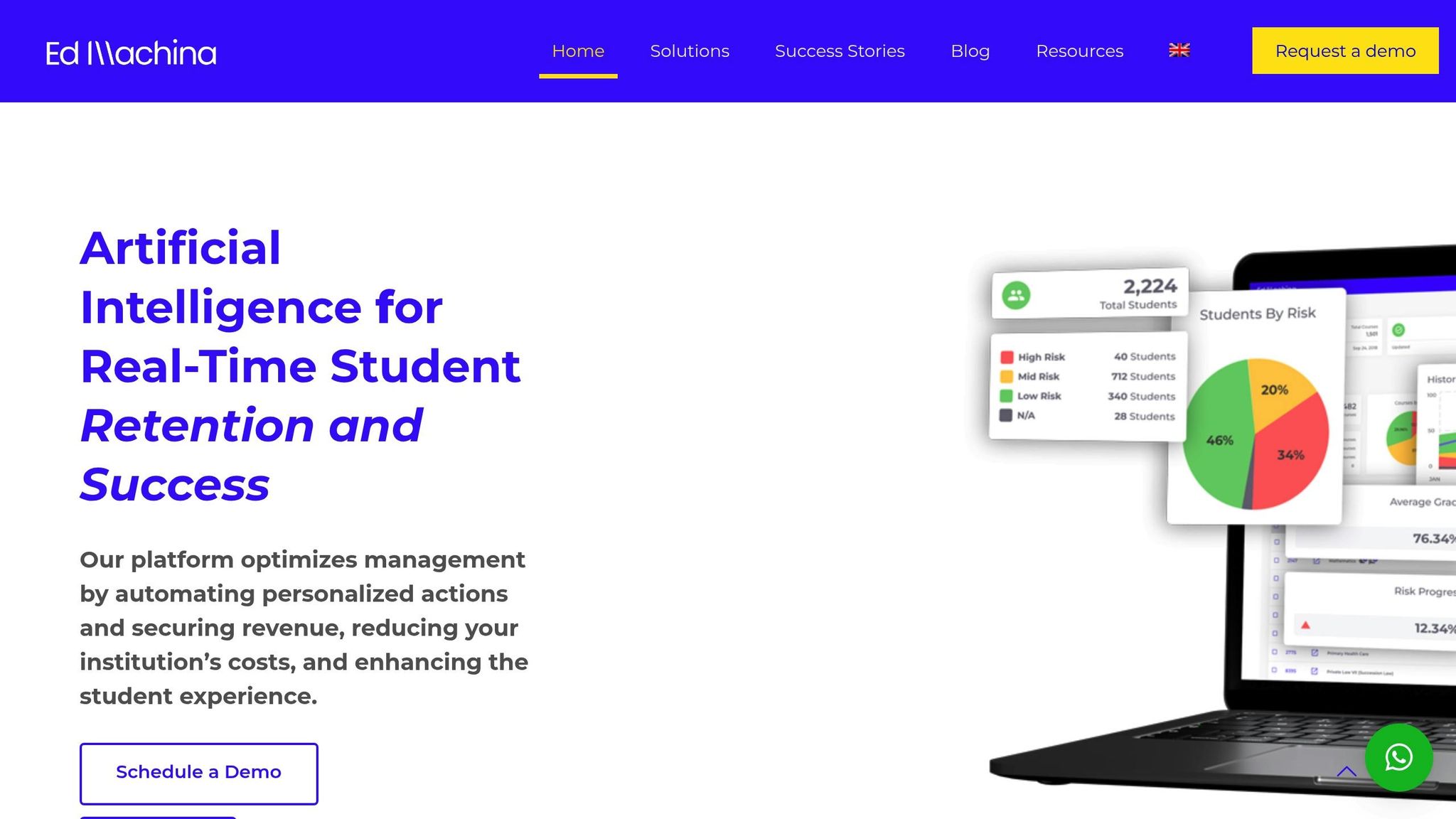
AI Models for Dropout Risk Prediction
AI tools are transforming how schools identify and support at-risk students. By analyzing data like grades, attendance, and engagement patterns, these systems predict dropout risks with 91% accuracy. Early warning signs - such as declining performance, irregular attendance, or reduced participation - can now be flagged before issues escalate. Platforms like QuizCat AI even provide personalized study materials to keep students on track.
Key Highlights:
- What AI Tracks: Grades, attendance, assignment completion, digital activity, and social behavior.
- Algorithms Used: XGBoost, Random Forests, and Neural Networks.
- Success Metrics: Improved retention rates, real-time interventions, and tailored support programs.
- Ethical Considerations: Addressing bias, protecting student data, and ensuring transparency.
AI isn’t just about data; it’s about timely action. By combining predictive insights with targeted interventions, schools can help more students succeed.
Ed Machina: transforming student success with AI-powered retention solutions.

AI Methods for Dropout Prediction
Advances in artificial intelligence are reshaping how schools and colleges tackle student dropouts. By analyzing patterns in student data, these systems can identify at-risk individuals early, allowing institutions to step in with targeted support. Let’s dive into the algorithms, data needs, and performance metrics that make these systems work.
Key AI Algorithms
Dropout prediction often relies on algorithms like tree-based models, neural networks, and decision trees. A standout example is XGBoost, a type of extreme gradient boosting, which has shown excellent accuracy when analyzing student records. Other tools like Random Forests and Neural Networks bring their own strengths, with their effectiveness depending on the type of data and the context in which they’re applied.
Required Data Types
For these AI systems to work well, they need a variety of information from different areas. Critical data includes:
- Academic Metrics: Grades, GPA trends, and assignment completion rates
- Behavioral Indicators: Attendance records, participation levels, and engagement metrics
- Demographic Data: Age, residence details, and employment status
- Digital Footprints: Interactions with Learning Management Systems (LMS)
- Administrative Records: Enrollment details, financial aid status, and program progress
By combining these data sources, the models become more accurate without requiring overly invasive student profiling.
Success Rate Measurements
Studies show that AI models for dropout prediction achieve an average accuracy of about 91% (95% CI = 89–93%). Regular updates to training data ensure these systems stay relevant as trends shift. Research also points to the need for tailored approaches, like gender-specific strategies, to address unique risk factors, emphasizing the importance of flexible and adaptive models.
Main Dropout Risk Indicators
Grade-Based Signals
AI models are particularly effective at identifying students who might be at risk of dropping out by analyzing their academic performance. Patterns like declining GPAs, failing core courses repeatedly, or leaving assignments incomplete are clear red flags. Some key academic indicators include:
- A steady drop in grades across multiple courses
- Struggles in core subjects that form the foundation of their education
- Low rates of assignment completion or late submissions
- Inconsistent performance across different subject areas
These academic trends often act as a gateway to exploring broader external and behavioral factors that contribute to dropout risk.
External Risk Factors
Academic performance isn’t the whole story. AI systems also factor in external variables that can heavily influence a student’s decision to leave school. Research highlights that socioeconomic and demographic aspects - like family income, financial aid eligibility, age, location, and gender - play a significant role in retention rates. Other factors include work commitments, family responsibilities, and living arrangements.
For example, a study involving 144,540 cases from an online university showed how combining demographic, academic, and engagement data could provide a more accurate picture of dropout risk.
Early Warning Signs
One of AI’s strengths lies in identifying subtle changes in behavior that might otherwise go unnoticed. These early warning signs often surface through shifts in digital engagement and participation patterns.
Digital Engagement Metrics:
- Decreased activity on learning management systems (LMS)
- Irregular login habits
- Reduced involvement in online discussions
Behavioral Patterns:
- Falling attendance rates
- Less participation in classroom activities
Tools like QuizCat AI take these insights further by offering personalized study materials and adaptive learning paths. By addressing these early signs, such platforms help mitigate risks associated with student disengagement and potential dropout.
sbb-itb-1e479da
Problems and Ethics
This section dives into the ethical challenges tied to AI-based dropout prediction systems, building on the discussion of dropout risk indicators.
Model Bias Issues
AI models used to predict dropout risks often struggle with algorithmic bias, especially when they disproportionately flag students from specific demographic groups as high-risk. Research highlights that these biases can unintentionally reinforce existing educational inequalities by misclassifying students from underrepresented backgrounds. The root of this issue lies in historical data, which tends to emphasize correlations rather than actual causes. For example, factors influencing dropout risks can vary significantly across different demographics, making it crucial to adopt more sensitive and tailored prediction methods. To address these biases, institutions should regularly conduct fairness audits, closely monitor outcomes, evaluate demographic impacts, and ensure training data is balanced and representative.
Student Data Protection
AI systems designed for dropout predictions must comply with privacy laws, such as the Family Educational Rights and Privacy Act (FERPA). These systems often handle sensitive student information, making it essential to implement strict access controls, encrypt data thoroughly, and anonymize it during both analysis and storage. This careful handling ensures student privacy is safeguarded while still enabling effective risk assessments. Striking this balance is critical - it allows institutions to identify at-risk students without infringing on their privacy rights. Moreover, protecting data privacy aligns with the broader need for transparency and accountability in AI decision-making.
AI Decision Transparency
Transparency in AI predictions is key to gaining the trust of educators and stakeholders. Explainable AI methods, like SHAP (SHapley Additive exPlanations), help break down complex predictions into understandable insights. Studies have shown that using these techniques can achieve prediction accuracies of approximately 91%. Tools like SHAP and interactive visualizations not only make predictions easier to interpret but also enable human oversight. Additionally, maintaining thorough documentation of the factors influencing predictions ensures that AI outputs are both actionable and easy to understand. This approach bridges the gap between advanced technology and practical, ethical application.
Next Steps in Dropout Prediction
Live Risk Monitoring
Modern AI systems now make it possible to monitor student engagement continuously. Studies reveal that AI models integrated with LMS data can achieve up to 91% accuracy in identifying at-risk students. Tools like XGBoost and Neural Networks analyze daily behaviors such as participation in online discussions, resource usage, and overall engagement. These systems go beyond just academic and behavioral signals, combining insights for real-time interventions. This shift from monitoring to direct action allows institutions to respond quickly, using these insights to implement targeted strategies that deliver measurable results.
Support Program Results
With continuous monitoring in place, institutions are developing structured frameworks to evaluate the impact of AI-driven interventions. Key performance metrics include:
| Metric Type | Measurement Focus | Tracking Period |
|---|---|---|
| Immediate Response | Attendance improvement | Daily/Weekly |
| Short-term Progress | Assignment completion | Monthly |
| Academic Performance | Grade progression | Quarterly |
| Long-term Outcome | Retention rates | Annually |
A/B testing is a popular method used to compare different intervention strategies, helping schools identify which approaches work best for various student profiles. This ongoing evaluation ensures that support programs stay effective and adaptable.
School Data Sharing
Collaboration between schools is becoming a key factor in refining predictive models. By sharing historical data, institutions can improve the accuracy of these systems. Research from Morocco demonstrates that shared frameworks can reach an 88% accuracy rate in identifying at-risk students.
Federated learning systems are at the heart of this collaboration, allowing models to be trained across multiple institutions while maintaining strict privacy safeguards. The future of dropout prediction depends on standardized data definitions and secure sharing protocols. These advancements enable schools to collectively analyze diverse student populations and educational environments, resulting in stronger predictive models and more effective interventions.
Conclusion
AI-powered tools are reshaping how schools and colleges tackle student retention. By identifying at-risk students early, these systems allow for timely, targeted interventions that can make all the difference.
Programs driven by AI insights have shown measurable success in keeping students engaged and on track. Early intervention strategies, informed by AI, offer more personalized and effective educational support.
"The flashcards are exceptional, but the podcast feature is my favorite. It reads my notes back to me while I'm at the gym or driving. Truly impressive!" - Ethan Blake
Looking ahead, AI is set to deepen its role in helping students succeed. Combining predictive analytics with tailored learning strategies, these systems can pinpoint challenges and suggest personalized solutions. For example, platforms like QuizCat AI (https://quizcat.ai) turn study materials into interactive quizzes, smart flashcards, and even podcasts, helping students focus on areas where they need the most help.
As schools refine their predictive models and embrace collaborative data-sharing, these AI tools will only get better. By blending cutting-edge technology with a human touch, educators can turn AI insights into meaningful actions that help students thrive.
FAQs
How do AI models like XGBoost and Neural Networks help predict student dropout risks accurately?
AI models like XGBoost and Neural Networks are transforming how educators identify students at risk of dropping out. These tools analyze vast amounts of data, including attendance records, grades, engagement levels, and socioeconomic information, to uncover patterns that may signal potential risks.
With the help of advanced algorithms, these models deliver precise predictions, allowing educators to step in early and provide personalized support. This kind of proactive intervention can make a big difference in keeping students on track and improving their overall success, showcasing the impact of AI in today's education system.
How do AI models address ethical concerns like data privacy and bias when predicting student dropout risks?
AI models aimed at predicting student dropout risks take several steps to tackle ethical challenges, particularly in the areas of data privacy and bias reduction. For privacy, strategies include anonymizing student information, using secure storage solutions, and adhering to regulations like FERPA in the U.S.
To address bias, developers rely on diverse and representative datasets during training. They also perform regular audits and testing to spot and fix unintended biases, ensuring the predictions remain fair and reliable for all students.
How can schools use AI tools to reduce dropout rates and boost academic success?
AI tools are proving invaluable in helping schools identify students who may be at risk and offering tailored interventions to support them. By examining data like attendance records, grades, and levels of participation, AI systems can predict which students might be in danger of falling behind or dropping out. This insight enables educators to step in early with support measures such as one-on-one tutoring, counseling, or mentorship programs.
Take QuizCat AI, for instance. This platform can enhance study habits by transforming learning materials into interactive quizzes, flashcards, and even podcasts. By making study sessions more engaging, QuizCat AI helps students deepen their understanding of subjects and stay motivated. Such tools are particularly beneficial for students facing academic hurdles, giving them the resources they need to succeed.
